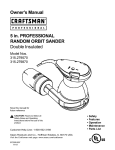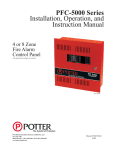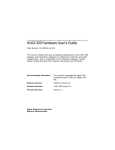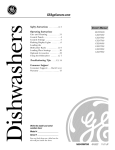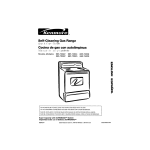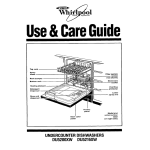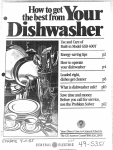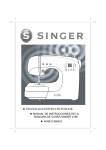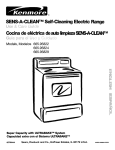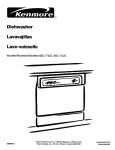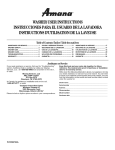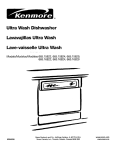Download Kenmore 665.15622 Dishwasher User Manual
Transcript
®
Ultra Wash Dishwasher
Lavavajillas Ultra Wash
Lave-vaisselle
Ultra Wash
Models/Modelos/Modeles
665.15622, 665.15629
3384413
Sears Roebuck and Co., Hoffman Estates, IL 60179 U.S.A.
Sears Canada, Inc., Toronto, Ontario, Canada M5B 2B8
www.sears.com
www.sears.ca
TABLE OF CONTENTS
WE SERVICE WHAT WE SELL ..........................................
2
WARRANTY .........................................................................
3
DISHWASHER
4
SAFETY
...................................................
Before Using Your Dishwasher ....................................................
PARTS
AND FEATURES
ULTRA WASWSoiI
START-UP
....................................................
Removal System ....................... _.................. 7
GUIDE ...............................................................
"Using Your New Dishwasher .......................................................
DISHWASHER
Loading
Loading
Loading
Loading
LOADING
..................................................
Suggestions ...................................................................
the Top Rack ..................................................................
the Bottom Rack ............................................................
the Silverware Basket ....................................................
DISHWASHER
USE ..........................................................
Detergent Dispenser ..................................................................
Rinse Aid Dispenser ...................................................................
Dishwasher Efficiency Tips ........................................................
Control Panel ..............................................................................
Cycle Selection Chart ................................................................
Canceling a Cycle ......................................................................
Changing a Cycle or Setting ......................................................
Adding Items During a Cycle .....................................................
Option Selections .......................................................................
Cycle Status Indicator ................................................................
Drying System ............................................................................
Overfill Protection Float ..............................................................
WASHING
SPECIAL
DISHWASHER
ITEMS
.............................................
CARE ........................................................
Cleaning Your Dishwasher .........................................................
Drain Air Gap ..............................................................................
Storing Your Dishwasher ...........................................................
TROUBLESHOOTING
5
6
.......................................................
7
7
8
8
8
9
9
WE SERVICE
WHAT WE SELL
"We Service What We Sell" is our assurance that you can depend
on Sears for service. Your dishwasher has added value when you
consider that Sears has service units nationwide, staffed with
professional technicians specifically trained on Sears appliances
and having the parts, tools, and equipment to ensure that we
meet our pledge to you..."We Service What We Sell."
Maintain the value of your KENMORE _ Dishwasher with a Sears
Maintenance Agreement. Sears dishwashers are designed,
manufactured, and tested for years of dependable operation. Yet,
any modern appliance may require service from time to time.
The Sears Maintenance Agreement
•
Is your way to buy tomorrow's service at today's prices.
10
•
Eliminates repair bills resulting from normal use.
10
11
11
12
12
13
13
13
13
13
14
14
•
Allows for as many service calls as required.
•
Provides for service by professional Sears Trained
Technicians.
•
Even if you don't need repairs, the Maintenance Agreement
offers an annual preventative maintenance check-up at your
request!
14
15
15
15
15
16
This Maintenance Agreement does not cover original installation,
reinstallation, or damage resulting from external causes such as
acts of abuse, theft, fire, flood, wind, lightning, freezing, power
fai)ure, power reduction, etc.
WARRANTY
FULL ONE-YEAR WARRANTY
ULTRA WASH ® DISHWASHERS
ON KENMORE
For one year from the date of purchase, when this dishwasher is
installed and operated according to instructions provided in the
Installation Instructions and Use & Care Guide, Sears will repair
this dishwasher, free of charge, if defective in material or
workmanship.
FULL WARRANTY
FOR THE LIFE OF THE DISHWASHER,
ON ULTRA LIFE TM TUB MODELS, AGAINST LEAKS IN THE
TUB AND INNER DOOR PANEL
For the life of the dishwasher, if a leak should occur as a result of
failure of the polypropylene tub or inner door panel due to
cracking, chipping or peeling, Sears will replace free of charge
the tub or inner door panel.
LIMITED TWO-YEAR
WASH SYSTEM
WARRANTY
ON THE ULTRA WASH
After the first year and until two years from the date of purchase,
when the dishwasher is installed and operated in accordance
with the instructions provided in the Installation Instructions
and Use & Care Guide, Sears will replace any part of the
ULTRA WASH wash system (motor, pump, spray arms, spray
tower, motor seals and pump gasket) due to defective materials
or workmanship. Customer assumes any labor costs associated
with replacement of these parts.
WARRANTY
RESTRICTION
If the dishwasher is subject to other than private family use, the
above warranty coverage is effective for only 90 days.
WARRANTY SERVICE
WARRANTY SERVICE IS AVAILABLE BY CONTACTING THE
NEAREST SEARS SERVICE CENTER IN THE UNITED STATES
OR CANADA. This warranty applies only while the product is in
use in the United States or Canada. This warranty gives you
specific legal rights and you may also have other rights which
vary from state to state or province to province.
Warranty terms may vary in Canada.
For Sears Warranty information
call 1-800-469-4663.
in the United States or Canada
Sears, Roebuck and Co.
D/817WA, Hoffman Estates, IL 60179
Sears Canada, Inc.
Toronto, Ontario, Canada M5B 2B8
In the space below, record your complete model number, serial
number, and purchase date. You can find this information on the
model and serial number label, located as shown in the Parts and
Features section of this book. Have this information available to
help you quickly obtain assistance or service when you contact
Sears concerning your appliance.
Model number _,
Serial number
Purchase
date
Save these instructions
reference.
and your sales receipt for future
3
DISHWASHER SAFETY
Your safety
and the safety of others are very important.
We have provided many important safety messages in this manual and on your appliance. Always read and obey all
safety messages.
This symbol alerts you to potential hazards that can kill or hurt you and others.
All
follow the safety alert symbol and either the word "DANGER" or
Thissafety
is themessages
safety alertwillsymbol.
"WARNING." These words mean:
You can be killed or seriously injured if you don't
immediately follow instructions,
You can be killed or seriously injured if you don't
follow instructions.
All safety messages will tell you what the potential hazard is, tell you how to reduce the chance of injury, and tell you
what can happen if the instructions are not followed.
IMPORTANT SAFETY INSTRUCTIONS
WARNING:
When using the dishwasher, follow basic precautions, including the following:
•
•
•
Read all instructions before using the dishwasher.
Use the dishwasher only for its intended function.
Use only detergents or rinse agents recommended
for use in a dishwasher, and keep them out of the
reach of children.
•
•
When loading items to be washed:
1) Locate sharp items so that they are not likely to
damage the door seat; and
2) Load sharp knives with the handles up to reduce
the risk of cut-type injuries.
• To reduce the risk of injury, do not allow children to
play in or on the dishwasher.
•
Do not wash plastic items unless they are marked
"dishwasher safe" or the equivalent. For plastic
items not so marked, check the manufacturer's
recommendations.
•
Do not touch the heating element during or
immediately after use.
Do not operate the dishwasher unless all enclosure
panels are properly in place.
• Do not tamper with controls.
• Do not abuse, sit on, or stand on the door or dish
racks of the dishwasher.
Under certain conditions, hydrogen gas may be
produced in a hot water system that has not been
used for two weeks or more. HYDROGEN GAS IS
EXPLOSIVE. If the hot water system has not been
used for such a period, before using the dishwasher
turn on all hot water faucets and let the water flow
from each for several minutes. This will release any
accumulated hydrogen gas. As the gas is flammable,
do not smoke or use an open flame during this time.
•
Remove the door to the washing compartment when
removing an old dishwasher from service or
discarding it.
SAVE THESE INSTRUCTIONS
GROUNDING
INSTRUCTIONS
For a grounded, cord-connected
dishwasher:
The dishwasher must be grounded. In the event
of a malfunction or breakdown, grounding will
reduce the risk of electric shock by providing a
path of least resistance for electric current. The
dishwasher is equipped with a cord having an
equipment-grounding conductor and a grounding
plug. The plug must be plugged into an appropriate outlet that is installed and grounded in
accordance with all local codes and ordinances.
Tip Over Hazard
WARNING:
Do not use dishwasher until completely installed.
Do not push down on open door.
Doing so can result in serious injury or cuts.
Improper connection of the
equipment-grounding
conductor can result in a
risk of electric shock. Check with a qualified
electrician or service representative if you are in
doubt whether the dishwasher is properly
grounded. Do not modify the plug provided with
the dishwasher; if it will not fit the outlet, have a
proper outlet installed by a qualified electrician.
For a permanently connected dishwasher:
The dishwasher must be connected to a
grounded metal, permanent wiring system, or an
equipment-grounding
conductor must be run
with the circuit conductors and connected to the
equipment-grounding
terminal or lead on the
dishwasher.
SAVE THESE INSTRUCTIONS
Electrical Shock Hazard
Electrically ground dishwasher.
Connect ground wire to green ground connector
in terminal box,
Do not use an extension cord.
Failure to follow these instructions can result in
death, fire, or electrical shock.
Install where dishwasher is protected from the elements.
Protect against freezing to avoid possible rupture of fill valve.
Such ruptures are not covered by the warranty. See "Storing
Your Dishwasher" in the "Dishwasher Care" section for winter
storage information.
Install and level dishwasher on a floor that will hold the
weight, and in an area suitable for its size and use.
Remove all shipping plugs from hoses and connectors
as the cap on the drain Outlet) before installing. See
Installation Instructions for complete information.
(such
PARTS AND FEATURES
_-_
it
b I{
10
11
12
13
I
14
15
7
9
1. Upper level wash
2. 3-position adjuster
3. Top rack
4. Bottom rack
5. Lower spray arm
6. Water inlet opening [in tub wall]
Control
13. Model and serial number label
14. ULTRA WASH® module
7. Rack bumper
8. Heating element
9. Vent
15. Overfill protection float
16. Detergent dispenser
17. Rinse aid dispenser
10. Top spray arm
11. Spray tower
12. Silverware basket
Panel
f
CYCLES
OPTIDNS
HEATING
;
4 DELAYHouR_
_
6
WA_,R MI_R I L_H_ W_J
|
The ULTRA WASH soil removal system gives you sparkling clean
dishes, while using less energy and time. The ULTRA WASH soil
removal system includes:
A heavy-duty grinder that acts as a food disposer to grind and
dispose of large food particles.
How the ULTRA WASH soil removal system works
1. Load the dishwasher. Remove bones, large chunks or
burned-on food. No rinsing is necessary. Any remaining food
soil will be ground up and disposed down the drain with the
rinse water.
2.
Hot water fills the dishwasher to a level near the bottom of
the overfill protection float.
3.
The Heating indicator glows and the dishwasher
the water is heated.
4.
When the water reaches the proper temperature, the Heating
indicator turns off and the cycle countdown resumes•
5.
Detergent from the detergent dispenser is dispensed at the
correct cycle times and hot water is pumped through the
ULTRA WASH pump.
6.
Hot water and detergent sprays against the soiled surfaces of
the load and removes food particles.
7.
Food soil is held in an accumulating
START-UP GUIDE
Before using your dishwasher, remove all hang tags, temporary
labels, and packaging materials. Read this entire Use and Care
Guide. You will find important safety information and useful
operating tips.
1.
Scrape large food soil and hard items (toothpicks
from dishes.
or bones)
2.
Properly load the dishwasher. (See "Loading Your
Dishwasher.") Make sure nothing prevents the ep,ay arm(s)
from spinning freely.
pauses while
chamber.
\
3.
Add detergent and check the rinse aid dispenser. Add rinse
aid if needed. (See "Using Your Dishwasher.")
.
8.
Food soil is disposed down the drain with the wash water.
9.
Fresh, hot water enters the dishwasher and sprays on the
dishes. The rinse water is then pumped through the
ULTRA WASH soil removal system and remaining soil
is removed.
10. The food soil that is held in the ULTRA WASH soil removal
system is disposed down the drain with the rinse water.
11. The final rinse water is heated. The rinse aid is added to the
water for the final rinse to prepare the dishes for drying.
4.
Push door firmly closed. The door latches automatically. Run
hot water at the sink nearest your dishwasher until the water
is hot. (See "Dishwasher Efficiency Tips.") Turn off water.
5.
Press the desired cycle and option selections. (See "Using
Your Dishwasher.") Turn the Cycle Control knob to the desired
cycle to start.
DISHWASHER
LOADING
i,
!
i
The top rack is designed for cups, glasses, and smaller items.
(See recommended loading patterns shown.)
NOTE: The features on your dishwasher
drawings shown.
rack may vary from the
Do not cover upper level wash. See arrow.
Remove leftover food, bones, toothpicks and other hard
items from the dishes. It is not necessary to rinse the dishes
before putting them in the dishwasher. The wash module
removes food particles from the water. The module contains a
chopping device which will reduce the size of food items.
NOTE: If hard items such as fruit seeds, nuts, and egg shells
enter the wash module, you might hear chopping, grinding,
crunching, or buzzing sounds. These sounds are normal
when hard items enter the module. Do not let metallic items
(such as pot handle screws) get into the wash module.
Damage can occur.
•
Load dishes so soiled surfaces face the spray (down or
inward). It is important for the water spray to reach all soiled
surfaces.
•
Load dishes so they are not stacked or overlapping if
possible. For best drying, water must be able to drain from all
surfaces.
•
Make sure pot lids and handles, pizza pans, cookie sheets,
etc., do not interfere with the spray arm rotation.
10 place setting
Run a rinse cycle to keep dishes moist if you do not plan to
wash them soon. Foods like eggs, rice, pasta, spinach, and
cooked cereals may be hard to remove if they are left to dry
over a period of time.
Quiet operating tips
To avoid thumping/clattering
noises during operation:
•
Make sure lightweight
•
Make sure pot lids and handles, pizza pans, cookie sheets,
etc., do not touch interior walls or interfere with the rotation of
the spray arm.
•
load items are secured in the racks.
Load dishes so they do not touch one another.
NOTE: For built-in models, keep sink drain plugs closed during
dishwasher operation to prevent noise transfer through drains.
8
12place setting
•
Place items so open ends face down for cleaning and
draining.
•
Load glasses in top rack only. The bottom rack is not
designed for glasses. Damage can occur.
•
Place cups and glasses in the rows between tines. Placing
them over the tines can lead to breakage and water spots,
•
China, crystal, and other delicate items must not touch each
other during dishwasher operation. Damage may occur.
•
Load plastic items in the top rack only. Only plastic items
marked "dishwasher safe" are recommended.
•
Load plastic items so the force of the spray does not move
them during the cycle.
•
To avoid chipping, do not let stemware touch other items.
•
Small bowls, pans, and other utensils can be placed in the
top rack. Load bowls in the center section for best stability.
Adjustable 3-position top rack
You can raise or lower the top rack to fit tall items in either the top
or bottom rack. Two adjusters are located on each side of the top
rack. Each adjuster has 3 preset positions. The high and low
positions are marked on the adjuster.
To adjust the top rack
1.
Load soup, cereal, and serving bowls in the rack in a variety
of ways depending upon their size and shape. Load bowls
securely between the rows of tines. Do not nest bowls
because the spray will not reach all surfaces.
Hold the top rack with one hand near the adjuster.
12 place setting
2.
With the other hand, pull out the top of the adjuster.
3.
Raise or lower the rack to one of the preset positions.
4.
Release the adjuster.
Repeat the steps for the remaining adjusters as needed. The 4
adjusters can be raised or lowered separately or together. The
top rack does not have to be level.
The bottom rack is designed for plates, pans, casseroles, and
utensils. Items with cooked-on or dried-on food should be loaded
with soiled surfaces facing inward to the spray. (See
recommended loading patterns shown.)
Load cookie sheets, cake pans, and other large items at the
sides and back. Loading such items in front can keep the
water spray from reaching the detergent dispenser and
silverware basket.
•
Secure heavily soiled cookware face down in the rack.
•
Make sure pot handles and other items do not stop rotation
of the spray arm(s). The spray arm(s) must move freely.
•
Do not load items between the bottom rack and the side of
the dishwasher tub. You can block the water inlet opening.
NOTE: If you have removed the bottom rack for unloading or
cleaning, replace it with the bumpers in front.
NOTE: The features on your dishwasher rack may vary from the
drawings shown.
Do not cover spray tower. See arrow.
Load the silverware basket while it is in the bottom rack or take
the basket out for loading on a counter or table,
NOTE: Unload or remove the basket before unloading the racks
to avoid spilling water droplets on the silverware,
•
Place small items like baby bottle caps, jar lids, corn cob
holders, etc., in the covered section. Close the cover to hold
small items in place.
Do not load glasses, cups, or plastic items in the bottom
rack. Load small items in the bottom rack only if they are
secured in place.
•
Load plates, soup bowls, etc., between tines and facing
inward to the spray.
This silverware basket can be separated and placed into the
bottom rack in several locations. Load silverware in all
sections or just one, depending upon your load.
•
When covers are up, mix items in each section of the basket
with some pointing up and some down to avoid nesting.
Spray cannot reach nested items.
10 place setting
Overlap the edges of plates for large loads.
IMPORTANT: Always load sharp items (knives, skewers, etc.)
pointing down,
9
To remove a small basket
1. Hold the center basket and one small basket. Slide the small
basket forward to release the tabs from the corresponding
slots.
How much detergent to use
•
The amount of detergent to use depends on the hardness of
your water and the type of detergent, if you use too little,
dishes won't be clean. If you use too much in soft water,
glassware will etch.
Water hardness can change over a period of time. Find out
your water's hardness by asking your local water department,
water softener company, or county extension agent.
Different brands of dishwasher detergent have different
amounts of phosphorous for softening water. If you have hard
water and use a detergent with a phosphorous content of less
than 8.7%, you might need to use more detergent, or use a
detergent with a phosphorous content higher than 8.7%.
2.
Pull the baskets aparL
Where to fill
NOTES:
•
Do not load silver or silver-plated silverware with stainless
steel. These metals can be damaged by contact with each
other dtJring washing.
•
Some foods (such as salt, vinegar, milk products, fruit juices,
etc.) can pit or corrode silverware. Run a rinse cycle if you do
not have a full load to wash immediately.
Top of 3rd step (3 tbs or 45 g)
Top of 2nd step (2 tbs or 30 g)
DISHWASHER USE
The detergent disoenser has 2 sections. The Pre-Wash section
empties detergent into the dishwasher when you close the door.
1
2
3
{'_
Top of 1st step (1 tb or 15 g)
Water Hardness
Amount
Soft to Medium
Hard Water
For normally
0 to 6 grains per
gallon
1.
2.
3.
4,
Cover
Main wash section
Cover latch
Pre-wash section
•
Add detergent just before starting a cycle.
•
Store tightly closed detergent in a cool, dry place. Fresh
automatic dishwasher detergent results in better cleaning.
NOTE: Do not use detergent with a rinse cycle.
Filling the dispenser
1. If the dispenser cover is closed, open the cover by pushing
the Cover latch.
2.
Fill the Main Wash section with detergent. See "How Much
Detergent to Use."
3.
Close the Main Wash dispenser cover. Fill the Pre-Wash
section if needed.
It is normal for the cover to open partially when dispensing
detergent.
NOTE: Use both sections for cycles with 2 washes. Use only the
covered section for cycles with 1 wash. See the "Cycle Selection
Chart" for more details.
soiled loads
•
Fill the Main Wash section to the
top of the 2nd step (2 tbs or 30 g)
•
Fill the Pre-Wash section to the
top of the 2nd step (2 tbs or 30 g)
if needed
NOTE: Add only 1 tb or 15 g of
detergent to both sections if dishes
are pre-rinsed or the water is very
soft (0 to 2 grains per gallon).
The larger Main Wash section automatically empties detergent
into the dishwasher during the main wash. (See the "Cycle
Selection Chart.")
•
Use automatic dishwasbing detergent only. Other detergents
can produce excessive suds that can overflow out of the
dishwasher and reduce washing performance.
10
of Detergent
4
For heavily soiled loads
•
Fill the Main Wash section to the
top of the 3rd step (3 tbs or 45 g)
•
Medium to Hard
Water
7 to 12 grains per
gallon
Fill the Pre-Wash section to the
top of the 2nd step (2 tbs or 30 g)
For normally soiled and
heavily soiled loads
•
Fill the Main Wash section to the
top of the 3rd step (3 tbs or 45 g)
•
Fill the Pre-Wash section to the
top of the 2nd step (2 tbs or 30 g)
if needed
NOTE: Fill amounts shown are for standard powdered detergent.
Amounts may vary if you use liquid or concentrated powdered
detergent. Follow instructions on the package when using liquid
dishwasher detergent or concentrated powdered detergent.
Rinse aids prevent water from forming droplets that can dry as
spots or streaks. They also improve drying by allowing water to
drain off of the dishes during the final rinse by releasing a small
amount of the rinse aid into the rinse water. Your dishwasl_er is
designed to use a liquid rinse aid. Do not use a solid or bar-type.
Hot water dissolves and activates the dishwashing detergent•
Hot water also dissolves grease on dishes and helps glasses dry
spot-free. For best dishwashing results, water must be at least
120°F (49°C) as it enters the dishwasher. Loads may not wash as
well if the water temperature is too low.
Checking the dispenser
Check the center of the Fill Indicator cap, Clear means it needs
filling.
To check water temperature
1. Run hot water at the faucet closest to your dishwasher
least 1 minute.
for at
2.
Place a candy or meat thermometer
cup.
in a glass measuring
3.
Check the temperature
running into the cup.
4.
If the water temperature at the faucet is below 120°F (49°C),
have a qualified person raise the water heater's thermostat
setting.
•
To save water and energy, do not rinse dishes before putting
them into the dishwasher•
•
Use a low energy, quick, or short cycle whenever possible•
These cycres use less hot water and energy than the Normal
cycle•
•
Use a delay feature (on some models) to run your dishwasher
during off-peak hours• Local utilities recommend avoiding
heavy usage of energy at certain times of day.
•
During the summer, run your dishwasher at night. This
reduces daytime heat buildup in the kitchen•
•
Use an air dry, or an energy-saving dry option whenever
possible• Allow longer drying times (overnight) when using
these options• Use a rinse aid to improve drying.
•
Use cycles or options that add extra heat to the wash or rinse
portion of the cycle only when needed•
•
Run your dishwasher with full loads• Run a rinse cycle after
meals until the dishwasher is full.
Or you can remove the Fill Indicator cap. If an "E" is visible, the
dispenser is empty.
Filling the dispenser
The rinse aid dispenser holds 6 oz (175 mL) of rinse aid. Under
normal conditions, this will last for about three months• You do
not have to wait until the dispenser is empty to refill it. Try to keep
it full, bat be careful not to overfill it.
1.
Make sure the dishwasher
door is completely
open.
2.
Remove the Fill Indicator cap.
3.
Add rinse aid. Fill to the smallest opening in the lower part of
the dispenser• Overfilling can cause the rinse aid to leak out,
and could cause oversudsing.
4.
Clean up any spilled rinse aid with a damp cloth•
5.
Replace the Fill Indicator cap. Close tightly.
on the thermometer
as the water is
11
OFF
Qur_< RIN
_,
!
QVlCKR_
DRY _
_
*_ 4 DElAY HoURs
HEATING
I
CYCLES
OPTIONS
_i_
Use this cycle for prerinsed and lightly-soiled
loads. This cycle uses
less hot water than the
Normal Wash cycle,
Press the desired cycle. Turn the Cycle Control knob to the
desired cycle. If the door is latched, you will hear the cycles start
and stop as the Cycle Control knob passes each cycle mark. This
is normal and does not hurt the dishwasher. If you prefer, you can
set the Cycle Control knob with the door unlatched.
To use Quick Rinse, press any cycle and turn the Cycle Control
knob to QUICK RINSE.
10iS pANS
Wash
Rinse
Use
covered
detergent
dispenser
section.
_;:
Main
Wash
Rinse
Dry
Time
(min)
W_rer
Usage
(gal/L)
•
•
140_F
(6ooc)
•
72*
4.3/16.3
NOTE: Use the Air Dry option with the Quick Rinse cycle.
A "e" shows what steps are in each cycle.
Temperatures indicate where extra heat is added.
Water usage is shown in U.S. gallons/liters,
Cycle time includes dry time. An asterisk ( * ) by the cycle time
indicates the cycle time might be longer depending on the
temperature of the water entering the dishwasher. The cooler the
water, the longer the cycle time. If the water is already hot
enough, the cycle time will be as shown.
LIGHT
NOTE: The Cycle Control knob pauses while water is being
heated.
Wash
Use this cycle for china
and crystal. This cycle
uses a light wash and
gentle dry. During the
heated dry, the heating
element cycles on and off.
Rinse
Main
Wash
•
clean, heavily-soiled pots,
pans, casseroles, and
Use
thistableware,
cycle for hard-toregular
detergent
dispenser
Use
both
sections.
Rinse
Main
Wash
Rinse
Dry
Time
(min)
Water
Usage
(gaUL)
•
140OF
•
•
140OF
•
14OOF
•
98*
8.5/32.2
(6o*c)
(sooc)
Wash
•
Rinse
12
Use both
detergent
dispenser
sections.
Rinse
Main
Wash
Rinse
•
Main
Wash
Rinse
Dry
Time
(min)
Water
Usage
(gaUL)
•
•
140°F
•
82*
6.4/24.2
(sooc)
Time
(rain)
•
cycled
72*
Use this rinse cycle for
rinsing dishes, glasses,
and silverware that will
not be washed right away.
Wash
Use this cycle for loads
with normal amounts of
food soil. (The energyusage label is based on
this cycle.)
1e°F40
Dry
Water
Usage
(gaUL)
4.8/18.2
(sooc)
Wash
(6ooc)
Rinse
Use
covered
detergent
dispenser
section.
Do not use
detergent
with this
cycle.
Dry
Time
(min)
Water
Usage
(gaUL)
6
2.2./8.3
I
Canceling
a Cycle
You can cancel a cycle at any time.
1.
Turn the Cycle Control knob slowly clockwise until you hear
water draining. Let the dishwasher drain completely.
2.
Open the door.
3.
Turn the Cycle Control knob to OFR
If your dishwasher has more than one wash cycle, you can
change a cycle anytime during a cycle.
1. Lift the door latch to stop the cycle.
Air Dry
Select this energy-saving option to dry without heat. Air drying is
useful when loads contain plastic dinnerware that may be
sensitive to high temperatures.
The dishes take longer to dry and some spotting can occur. For
best drying, use a liquid rinse aid. Some items (such as plastics)
may need towel drying.
NOTE: Quick Rinse and Light Wash automatically
Air Dry is an option with all other cycles.
use this option.
2.
Turn the Cycle Control knob clockwise.
Reset
3.
Check the detergent dispensers.
for the new cycle.
Select Reset to change an option anytime before the selected
option begins.
They must be filled properly
@
NOTE: Turning the Cycle Control knob can cause the covered
Detergent Dispenser section to open and release the
detergent. Check the covered section if the cycle uses
detergent in both sections.
4,
Close the door firmly until it latches. The dishwasher starts a
new cycle.
Adding Items During a Cycle
You can add an item anytime before the main wash starts, or the
Cycle Control knob reaches Light Wash/Water Miser.
1.
2.
3.
4.
Lift up the door latch to stop the cycle. Wait for the spraying
action to stop before opening the door.
Delay Hours
Select this option to run your dishwasher at a later time or during
off-peak hours.
You can delay the start of a cycle up to 6 hours.
To delay the start
1. Close the door.
2.
Select a wash cycle and options.
Press the desired cycle. Turn the Cycle Control knob
clockwise to the number of hours you want the dishwasher to
delay the start.
Open the door and add the item.
Close the door, but do not latch it. Wait 30 seconds for the air
in the dishwasher to warm up. This reduces the amount of
moisture escaping from the vent when restarting a cycle.
Close the door firmly until it latches. The dishwasher resumes
the cycle.
Option Selections
You can customize your cycles by pressing an option. If you
change your mind, press RESET to turn the option off. Select a
different option if desired.
You can change an option anytime before the selected option
begins. For example, you can press an unheated drying option
any time before drying begins,
Hi Ternp Wash
Select this option to heat the water to 140°F (60°C) during parts
of the cycle. Heating the water helps improve washing results.
This option adds both heat and wash time to parts of the cycle.
Hi Temp Wash is useful when loads contain baked-on food.
NOTE: Pots Pans automatically uses this option. Hi Temp Wash
is an option with the Normal Wash, Water Miser and Light Wash
cycles.
The dishwasher starts the cycle in the selected number of
hours. You can add items while the time is counting down.
3.
Close and latch the door. The Cycle Control knob will not
advance if the door is unlatched.
NOTE: Quick Rinse, Water Miser and Light Wash cycles cannot
be delayed.
IMPORTANT:
•
Operate your dishwasher
only when you are at home.
•
If your home is equipped with a water softener, do not start
the dishwasher during the regeneration of the softener.
Heating
HEATING glows, and the cycle progression pauses, whenever
water is heated during a cycle. Wash or rinse action continues as
the water heats.
J
HEATING
13
During drying, you can see steam escaping through the vent at
the upper left corner of the door. This is normal as the heat dries
your dishes.
,-.-.,,' "¢."
Material
Dishwasher
Crystal
Yes
Check manufacturer's recommendations
before washing. Some types of leaded
crystal can etch with repeated washing.
Gold
No
Gold-colored
Glass
IMPORTANT: The vapor is hot. Do not touch the vent
during drying.
The overfill protection float (in the front right corner of the
dishwasher tub) keeps the dishwasher from overfilling. It must be
in place for the dishwasher to operate.
Check under the float for objects that may keep the protector
from moving up or down.
WASHING SPECIAL
ITEMS
Dishwasher
Aluminum
Yes
No
Handles of some knives are attached to
the blade with adhesives which can
loosen if washed in the dishwasher.
Pewter, Brass,
No
Bronze
High water temperatures and detergent
can discolor or pit the finish.
Disposable
Plastics
No
Cannot withstand high water
temperatures and detergents.
Plastics
Yes
Always check manufacturer's
recommendations before washing.
Plastics vary in their capacity to withstand
high temperatures and detergents. Load
plastics in top rack only.
Stainless Steel
Bottles and Cans
Sterling Silver or
Yes
Silver Plate
Run a rinse cycle if not washing
immediately. Prolonged contact with food
containing salt, acid, or sulfide (eggs,
mayonnaise, and seafood) can damage
finish.
Tin
No
No
No
Wash bottles and cans by hand. Labels
attached with glue can loosen and clog
the spray arms or pump and reduce
washing performance.
Cast Iron
No
Seasoning will be removed and iron will
rust.
China/
Yes
Stoneware
Always check manufacturer's
recommendations before washing.
Antique, hand-painted, or over-the-glaze
patterns may fade. Gold leaf can discolor
or fade.
14
Yes
Run a rinse cycle if not washing
immediately. Prolonged contact with food
containing salt, vinegar, milk products, or
fruit juice can damage finish.
Safe?/Comments
Do not wash throwaway aluminum pans
in the dishwasher. These might shift
during washing and transfer black marks
to dishes and other items.
Yes
Hollow-Handle
Knives
High water temperature and detergents
can affect finish of anodized aluminum.
Disposable
Aluminum
flatware will discolor.
Milk glass yellows with repeated
dishwasher washing.
If you have doubts about washing a particular item, check with
the manufacturer to see if it is dishwasher safe.
Material
Safe?/Comments
Can rust.
Wooden Ware
No
Wash by hand. Always check
manufacturer's instructions before
washing. Untreated wood can warp,
crack, or lose its finish.
DISHWASHER CARE
Cleaning the exterior
In most cases, regular use of a soft, damp cloth or sponge and a
mild detergent is all that is necessary to keep the outside of your
dishwasher looking nice and clean.
Check the drain air gap anytime your dishwasher isn't
draining well.
Some state or local plumbing codes require the addition of a
drain air gap between a built-in dishwasher and the home drain
system. If a drain is clogged, the drain air gap protects your
dishwasher from water backing up into it.
1
\
Cleaning the interior
Hard water minerals can cause a white film to build up on the
inside surfaces, especially just beneath the door area.
Do not clean the dishwasher interior until it has cooled. Wear
rubber gloves. Do not use any type of cleanser other than
dishwasher detergent because it may cause foaming or sudsing.
To clean interior
Make a paste with powdered dishwasher detergent on a damp
sponge and clean.
OR
Use liquid automatic dishwasher
damp sponge.
OR
detergent and clean with a
See the vinegar rinse procedure in "Spotting and filming on
dishes" in "Troubleshooting."
NOTE: Run a Normal cycle with detergent after cleaning the
interior.
The drain air gap is usually located on top of the sink or
countertop near the dishwasher. To order a drain air gap call
1-800-366-7278 and ask for Part Number 300096.
NOTE: The drain air gap is an external plumbing device that is
not part of your dishwasher. The warranty provided with your
dishwasher does not cover service costs directly associated with
the cleaning or repair of the external drain air gap.
To clean the drain air gap
Clean the drain air gap periodically to ensure proper drainage of
your dishwasher. Follow the cleaning instructions provided by the
manufacturer. With most types, you lift off the chrome cover.
Unscrew the plastic cap. Then check for any soil buildup. Clean
if necessary.
Storing for the summer
Protect your dishwasher during the summer months by turning
off the water supply and power supply to the dishwasher.
Winterizing your dishwasher
Protect your dishwasher and home against water damage due to
freezing water lines, if your dishwasher is left in a seasonal
dwelling or could be exposed to near freezing temperatures, have
your dishwasher winterized by authorized service personnel.
15
TROUBLESHOOTING
Dishes are not completely clean
Food soil left on the dishes
•
Is the dishwasher loaded correctly? Refer to the "Dishwasher
Loading" section.
First try the solutions suggested here and possibly avoid
the cost of a service call,.,
Is the water temperature too low? If needed, turn home
water heater up to ensure water entering dishwasher is at
least 120°F (49°C). Refer to the "Dishwasher Efficiency
Tips" section•
Dishwasher is not operating properly
•
Dishwasher does not run or stops during a cycle
is the door closed tightly and latched?
Did you use the correct amount of fresh detergent? Use
recommended dishwasher detergents only. Refer to the
"Detergent Dispenser" section. Never use less than 1 tb
(15 g) per load. Detergent must be fresh to be effective. Store
detergent in a cool, dry area. Heavy soil and/or hard water
generally require extra detergent.
Is the right cycle selected? Refer to the "Cycle Selection
Chart."
Is there power to the dishwasher?
blown or circuit breaker tripped?
•
Has a household fuse
Has the motor stopped due to an overload? The motor
automatically resets itself within a few minutes. If it does not
restart, call for service.
Is detergent caked in dispenser? Use fresh detergent only. Do
not allow detergent to sit for several hours in a wet dispenser.
Clean dispenser when caked detergent is present.
Is the water shut-off valve (if installed) turned on?
Is the pump or spray arm clogged by labels from bottles and
cans? Remove labels before washing bottles and cans or
wash by hand.
Dishwasher
will not fill
is the overfill protection float able to move up and down
freely? Press down to release.
•
Dishwasher
Is the home water pressure high enough for proper
dishwasher filling? Home water pressure should be
20 to 120 psi (138 to 828 kPa) for proper dishwasher fill. A
booster pump on the water supply can be added if pressure
is too low.
seems to run too long
Is the water supplied to the dishwasher hot enough? The
dishwasher runs longer while heating water. Refer to the
"Water Temperature Tips" section.
Are high suds slowing the wash arm? Never use soap or
laundry detergents. Use recommended dishwasher
detergents only.
A delay automatically occurs in some wash and rinse cycles
until the water reaches the proper temperature.
•
Water remains in the dishwasher
Spots and stains on dishes
Is the cycle complete?
•
Detergent remains in the covered section of the
dispenser
Is the cycle complete?
Is the detergent lump-free? Replace detergent if necessary.
Is the bottom rack installed properly with the bumpers in the
front? Refer to the "Parts and Features" section. Reinstall the
rack if necessary.
•
White residue on the front of the access panel
Was too much detergent used? Refer to the "Detergent
Dispenser" section.
Is the brand of detergent making excess foam? Try a different
brand to reduce foaming and eliminate buildup.
•
Odor in the dishwasher
Are dishes washed only every 2 or 3 days? Run a rinse cycle
once or twice a day until you have a full load.
Does the dishwasher have a new plastic smell? Run a vinegar
rinse as described in "Spotting and filming on dishes" later in
this Troubleshooting guide.
•
Condensation
on the kitchen counter (built-in models)
Is the dishwasher aligned with the counter top? Moisture
from the vent in the dishwasher console can form on the
counter. Refer to the Installation Instructions for more
information.
16
•
Spotting and filming on dishes
Is your water hard or is there a high mineral content in your
water? Conditioning the final rinse water with a liquid rinse
aid helps eliminate spotting and filming. Keep the rinse aid
dispenser filled,
Is the water temperature too low? if needed, turn home
water heater up to ensure water entering dishwasher is at
least 120°F (49°C). Refer to the "Dishwasher Efficiency
Tips" section.
Did you use the correct amount of effective detergent? Use
recommended dishwasher detergents only. Refer to the
"Detergent Dispenser" section. Never use less than 1 tb (15 g)
per load. Detergent must be fresh to be effective. Store
detergent in a cool, dry area. Heavy soil and/or hard water
generally require extra detergent.
Is the home water pressure high enough for proper
dishwasher filling? Home water pressure should be 20 to 120
psi (138 to 828 kPa) for proper dishwasher fill. A booster
pump on the water supply can be added if pressure is too
low.
NOTE: To remove spots and film from dishes, try a white
vinegar rinse. This procedure is intended for occasional use
only, Vinegar is an acid and using it too often could damage
your dishwasher.
Dishes are damaged
•
1.
Wash and rinse dishes. Use an air-dry or an energy saving
dry option. Remove all silverware or metal items.
2. Put 2 cups (473 mL) white vinegar in a glass or
dishwasher-safe measuring cup on the bottom rack.
3. Run the dishwasher through a complete washing cycle
using an air-dry or an energy saving dry option. Do not
use detergent. Vinegar will mix with the wash water.
Silica film or etching (silica film is a milky, rainbowcolored deposit; etching is a cloudy film)
Sometimes there is a water/chemical reaction with certain
types of glassware. This is usually caused by some
combination of soft or softened water, alkaline washing
solutions, insufficient rinsing, overloading the dishwasher,
and the heat of drying. It might not be possible to prevent the
problem, except by hand washing.
during a cycle
Chipping of dishes
Did you load the dishwasher properly? Load the dishes and
glasses so they are stable and do not strike together from
washing action. Minimize chipping by moving the rack in and
out slowly.
NOTE: Antiques, feather-edged crystal, and similar types of
china and glassware might be too delicate for automatic
dishwashing. Wash by hand.
Noises
•
Grinding, grating, crunching or buzzing sounds
A hard object has entered the wash module (on some
models). The sound should stop when the object is
ground up.
To slow this process use a minimum amount of detergent but
not less than 1 tb (15 g) per load. Use a liquid rinse aid and
underload the dishwasher to allow thorough rinsing. Silica
film and etching are permanent and cannot be removed. Do
not use heated drying.
•
White spots on cookware with non-stick finish
Has the dishwasher detergent removed cookware
seasoning? Reseason cookware after washing in the
dishwasher.
•
Brown stains on dishes and dishwasher interior
Does your water have high iron content? Rewash dishes
using 1-3 tsp (5-15 mL) of citric acid crystals added to the
covered section of the detergent dispenser. Do not use
detergent. Follow with a Normal wash cycle with detergent. If
treatment is needed more often than every other month, the
installation of an iron removal unit is recommended.
•
Black or gray marks on dishes
Are aluminum items rubbing dishes during washing?
Disposable aluminum items can break down in the
dishwasher and cause marking. Hand wash these items.
Remove aluminum markings by using a mild abrasive cleaner.
•
Orange stains on plastic dishes or dishwasher
interior
Are large amounts of tomato-based foods on dishes placed
in the dishwasher? Stains gradually fade over time. Regular
use of heated drying will slow fading. Stains will not affect
dishwasher performance. Regular use of a rinse cycle and an
air-dry or energy-saving dry option will reduce the likelihood
of staining.
Dishes do not dry completely
•
Dishes are not dry
Did you load your dishwasher to allow proper water
drainage? Do not overload, Refer to the "Dishwasher
Loading" section. Use a liquid rinse aid to speed drying.
Are the plastics wet? Plastics often need towel drying.
Is the rinse aid dispenser empty? Refer to the "Rinse Aid
Dispenser" section.
Did you use an air-dry or energy-saving
heated drying option for dryer dishes.
dry option? Use a
17
18
Get it fixed, at your home or ours!
For repair of major brand appliances in your own I1Qnr_...
no matter who made it, no matter who sold it!
1-8004-MY-HOME
sMAnytime,
day or night
(1-8004694663)
www.sears.com
To bring in products such as vacuums, lawn equipment and electronics
for repair, call for the location of your nearest Sears Parts & Repair Center
1-800488- ! 222
Anytime, day or night
t_lNw,sears,com
For the replacement parts, accessories and owner's manuals
that you need to do-it-yourself, call Sears PartsDirectsM!
1-800-366-PART
6a.m.-
(!-800-366-7278)
11p.m. CST,
7days aweek
www, sears.com/partsdirect
To purchase or inquire about a Sears Service Agreement"
! -800-827-6655
7 a.m.-
5 p.m. CST, Mon.-Sat.
Para pedir servicio de reparaciOn a domicilio,
y para ordenar piezas con entrega a domicilio:
1-888-SU-IK)GAR
_
Au Canada pour service en f_anc,ais:
i -877-LE-FOYI_
_'
(1-877-533-6937)
(1-888-784-6427)
SEARS
HomeCentra/_
8384413
2000 Kenmore
® Registered Trademark/TM Trademark of Sears, Roebuck and Co., under licensee by Sears Canada
® Marca Registrada/TM rnarca de fabrica de Sears, Ro_buok and Co., con licenc_ de Sears Canada
® Marque depo.sL_JTM Manque de cornme_ce de Sears, Roebuck and Co., en vertu d'un par license par Seam Canada
5!00
Printed in U.S.A.
Irnpreso en Los EE. UU.
Impnrr_ aux _.-U




















